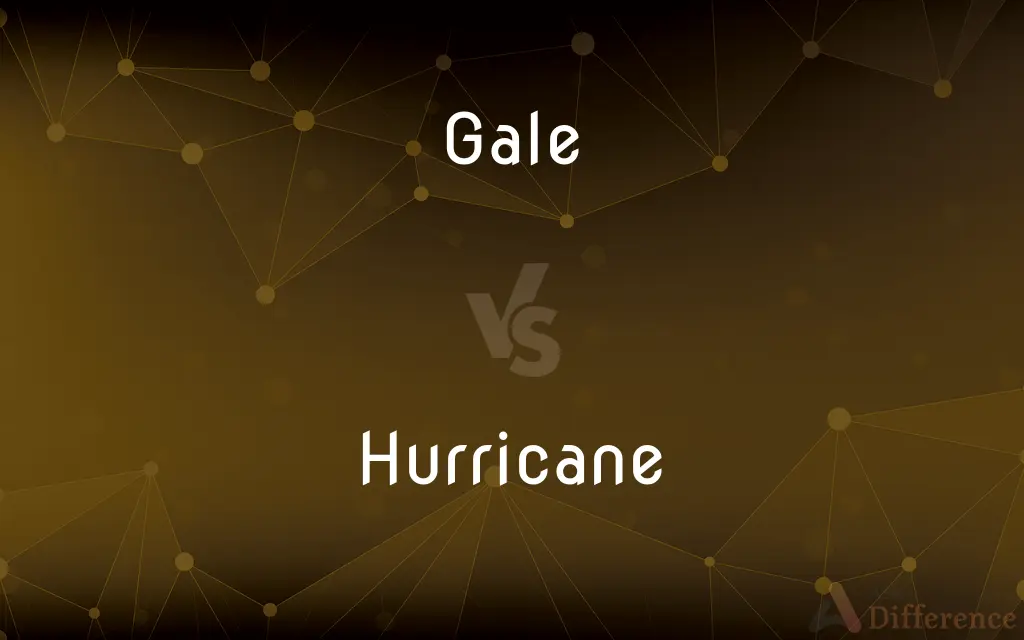Gale vs. Hurricane — What's the Difference?
By Tayyaba Rehman & Urooj Arif — Updated on March 13, 2024
Gale is a strong wind, typically used in nautical contexts, while hurricane refers to a powerful tropical storm.

Difference Between Gale and Hurricane
Table of Contents
ADVERTISEMENT
Key Differences
A gale is defined as a very strong wind, with speeds ranging from 34 to 47 knots (39 to 54 miles per hour or 63 to 88 kilometers per hour) according to the Beaufort scale. It is often used in maritime and meteorological contexts to describe winds that are strong enough to significantly affect sea conditions and land activities, potentially causing damage to structures and vegetation. In contrast, a hurricane is a type of tropical cyclone characterized by a low-pressure center, spiral rainbands, and strong winds rotating around a central eye. Hurricanes form over warm tropical oceans and gain energy from the heat of the sea.
While gales can occur in various environments and are primarily defined by wind speed, hurricanes are specific to tropical regions and involve a combination of high winds, low pressure, and rain. The impact of a gale is usually less severe than that of a hurricane, which can cause widespread devastation over large areas, including damage to infrastructure, homes, and the natural environment.
Gales can be part of larger weather systems, such as extratropical cyclones, and can affect both coastal and inland areas. They may lead to rough sea conditions, making maritime travel hazardous. Hurricanes, however, are more structured weather systems with a defined path and evolution, and their impact is closely monitored and forecasted by meteorological agencies.
The terminology used to describe these wind phenomena varies by region; for example, hurricanes are known as typhoons in the Northwest Pacific and simply as tropical cyclones in the South Pacific and Indian Ocean. Regardless of the term, the emphasis is on preparedness and understanding the risks associated with these powerful natural events.
Comparison Chart
Definition
A strong wind, typically 34-47 knots
A tropical cyclone with winds ≥74 mph
ADVERTISEMENT
Context
Maritime and meteorological
Tropical regions
Impact
Can cause damage to structures, affect sea conditions
Widespread devastation, including wind damage, flooding
Scale
Beaufort scale
Saffir-Simpson Hurricane Wind Scale
Occurrence
Various parts of the world, not tied to specific storms
Warm tropical oceans, specific seasons
Compare with Definitions
Gale
A strong wind often affecting maritime activities.
The ship's captain navigated carefully through the gale.
Hurricane
Characterized by a low-pressure center and spiral rainbands.
Satellite images showed the hurricane's immense size and spiral bands.
Gale
Measured on the Beaufort scale, typically 34-47 knots.
The forecast warned of gale-force winds affecting the coast.
Hurricane
A powerful tropical cyclone with a well-defined structure.
The hurricane's eye passed over the island, causing a temporary calm.
Gale
Not necessarily associated with a specific type of storm.
A sudden gale caught the sailors off guard during their voyage.
Hurricane
Can lead to extensive damage, including storm surges and flooding.
The hurricane caused widespread flooding, damaging many homes.
Gale
Can cause significant sea disturbance and damage.
The coastal town prepared for the gale by securing outdoor items.
Hurricane
Categorized by the Saffir-Simpson scale, starting at 74 mph winds.
The Category 3 hurricane brought devastating winds to the coastline.
Gale
Affects both sea and land activities.
The gale caused trees to fall, blocking several roads in the area.
Hurricane
Specific to warm tropical oceans and certain seasons.
The community prepared for hurricane season by reinforcing their homes.
Gale
A gale is a strong wind, typically used as a descriptor in nautical contexts. The U.S. National Weather Service defines a gale as 34–47 knots (63–87 km/h, 17.5–24.2 m/s or 39–54 miles/hour) of sustained surface winds.
Hurricane
A severe tropical cyclone having winds greater than 64 knots (74 miles per hour; 119 kilometers per hour), originating in the equatorial regions of the Atlantic Ocean or Caribbean Sea or eastern regions of the Pacific Ocean, traveling north, northwest, or northeast from its point of origin, and usually involving heavy rains.
Gale
A wind with a speed of from 34 to 40 knots (39 to 46 miles per hour; 63 to 74 kilometers per hour), according to the Beaufort scale. Also called fresh gale.
Hurricane
A wind with a speed greater than 64 knots (74 miles per hour; 119 kilometers per hour per hour), according to the Beaufort scale.
Gale
A storm at sea.
Hurricane
Something resembling a hurricane in force or speed.
Gale
Often gales A forceful outburst
Gales of laughter.
Hurricane
A severe tropical cyclone in the North Atlantic Ocean, Caribbean Sea, Gulf of Mexico, or in the eastern North Pacific off the west coast of Mexico, with winds of 119 km/h (74 miles per hour) or greater accompanied by rain, lightning, and thunder that sometimes moves into temperate latitudes.
Gale
The sweet gale.
Hurricane
(meteorology) A wind scale for quite strong wind, stronger than a storm
Gale
To sing; charm; enchant.
Hurricane
"full—triple-full—full" – an acrobatic maneuver consisting of three flips and five twists, with one twist on the first flip, three twists on the second flip, one twist on the third flip
Gale
To cry; groan; croak.
Hurricane
A violent storm, characterized by extreme fury and sudden changes of the wind, and generally accompanied by rain, thunder, and lightning; - especially prevalent in the East and West Indies. Also used figuratively.
Like the smoke in a hurricane whirl'd.
Each guilty thought to me isA dreadful hurricane.
Gale
To talk.
Hurricane
A severe tropical cyclone usually with heavy rains and winds moving a 73-136 knots (12 on the Beaufort scale)
Gale
To call.
Gale
To sing; utter with musical modulations.
Gale
(nautical) To sail, or sail fast.
Gale
(meteorology) A very strong wind, more than a breeze, less than a storm; number 7 through to 9 winds on the 12-step Beaufort scale.
It's blowing a gale outside.
Many parts of the boat were damaged in the gale.
Gale
An outburst, especially of laughter.
A gale of laughter
Gale
A light breeze.
Gale
A shrub, also called sweet gale or bog myrtle (Myrica gale), that grows on moors and fens.
Gale
(archaic) A periodic payment, such as is made of a rent or annuity.
Gale day - the day on which rent or interest is due.
Gale
A strong current of air; a wind between a stiff breeze and a hurricane. The most violent gales are called tempests.
Gale
A moderate current of air; a breeze.
A little gale will soon disperse that cloud.
And winds of gentlest gale Arabian odors fannedFrom their soft wings.
Gale
A state of excitement, passion, or hilarity.
The ladies, laughing heartily, were fast getting into what, in New England, is sometimes called a gale.
Gale
A song or story.
Gale
A plant of the genus Myrica, growing in wet places, and strongly resembling the bayberry. The sweet gale (Myrica Gale) is found both in Europe and in America.
Gale
The payment of a rent or annuity.
Gale
To sale, or sail fast.
Gale
To sing.
Gale
A strong wind moving 45-90 knots; force 7 to 10 on Beaufort scale
Common Curiosities
How are hurricane strengths categorized?
Hurricane strengths are categorized by the Saffir-Simpson Hurricane Wind Scale, ranging from Category 1 to Category 5, based on their maximum sustained wind speeds.
How do meteorologists predict the path of a hurricane?
Meteorologists use satellite imagery, weather models, and historical data to predict the path of a hurricane, taking into account various atmospheric and oceanic conditions.
What defines a gale in meteorological terms?
A gale is defined as a very strong wind, with speeds typically ranging from 34 to 47 knots, often affecting maritime activities and causing sea disturbances.
Can the impact of a gale be as severe as that of a hurricane?
While gales can cause significant damage, especially to maritime activities and coastal areas, the impact of a hurricane is generally more severe and widespread, including extensive structural damage and flooding.
What role do warm ocean waters play in hurricane development?
Warm ocean waters provide the energy necessary for hurricane development, as the warm sea surface heats the air above, leading to convection and the formation of storm systems.
How do hurricane warning systems help minimize damage?
Hurricane warning systems, including forecasts and alerts, help minimize damage by providing timely information, allowing for evacuation plans, and enabling protective measures to be put in place.
Can gales occur outside of tropical regions?
Yes, gales can occur in various parts of the world, including outside of tropical regions, and are not necessarily associated with tropical cyclones.
What factors contribute to the formation of a hurricane?
Hurricanes form over warm tropical oceans, drawing energy from the warm sea surface, and require specific atmospheric conditions, including low wind shear and sufficient moisture.
How does a hurricane differ from other types of storms?
A hurricane is a specific type of tropical cyclone with a well-defined structure, including a low-pressure center, spiral rainbands, and strong winds, causing extensive damage through wind, rain, and storm surges.
Can gales lead to power outages and infrastructure damage?
Yes, gales can lead to power outages and infrastructure damage, particularly by uprooting trees, damaging power lines, and affecting buildings.
What preparations are necessary for a gale warning?
Preparations for a gale warning may include securing outdoor objects, reinforcing windows and doors, and avoiding maritime activities to mitigate the impact of strong winds.
What are the long-term effects of hurricanes on affected communities?
The long-term effects of hurricanes on affected communities can include economic hardship, displacement, environmental damage, and the need for extensive rebuilding and recovery efforts.
Are there specific regions more prone to hurricanes?
Yes, specific tropical regions, such as the Atlantic and Pacific Oceans near the equator, are more prone to hurricanes, especially during certain seasons.
How do communities recover from hurricane damage?
Communities recover from hurricane damage through a combination of emergency response efforts, rebuilding infrastructure, support from government and aid organizations, and community resilience initiatives.
Are there technological advancements that aid in hurricane tracking?
Yes, technological advancements such as satellite imagery, radar technology, and computer modeling have significantly improved the accuracy of hurricane tracking and forecasting.
Share Your Discovery

Previous Comparison
Beginning vs. Starting
Next Comparison
Appertain vs. PertainAuthor Spotlight
Written by
Tayyaba RehmanTayyaba Rehman is a distinguished writer, currently serving as a primary contributor to askdifference.com. As a researcher in semantics and etymology, Tayyaba's passion for the complexity of languages and their distinctions has found a perfect home on the platform. Tayyaba delves into the intricacies of language, distinguishing between commonly confused words and phrases, thereby providing clarity for readers worldwide.
Co-written by
Urooj ArifUrooj is a skilled content writer at Ask Difference, known for her exceptional ability to simplify complex topics into engaging and informative content. With a passion for research and a flair for clear, concise writing, she consistently delivers articles that resonate with our diverse audience.














































